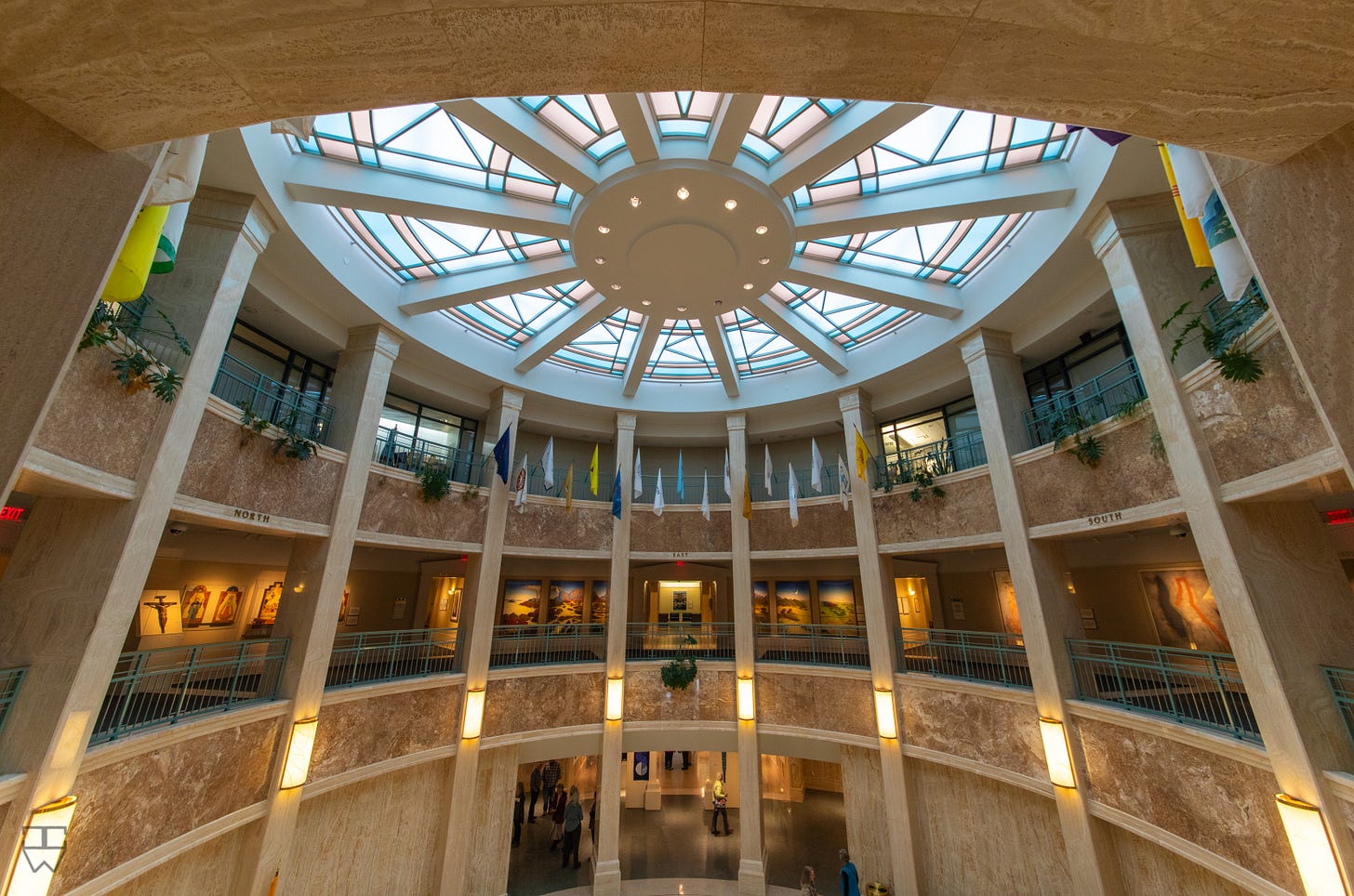View photo as large as possible
The rotunda of the New Mexico Capitol, known as 'The Roundhouse', so known because the building is in fact round. The only round capitol building in the US. The design incorporates elements of New Mexico Territorial, Pueblo and Greek Revival.
(Note to photographers of architecture; yes, the perspective is all wrong, but I hated the 'corrected' version. The skylight completely dominated the image.)
The stone is New Mexico Travertine marble. The stained glass skylight is a native basket pattern symbolizing sky and earth. The layout of the building mimics the sun symbol of Zia Pueblo, which is also the symbol on New Mexico's flag. The Zia sun represents the four cardinal directions, the four seasons, the four stages of life and the four sacred obligations: a strong body, a clear mind, a pure spirit and a devotion to the welfare to others.
The Zia symbol was appropriated and used by the state for 75 years before the issues surrounding its use were partially resolved through the diplomacy of Bill Richardson (US House of Representatives, Ambassador to the U.N., Secretary of Energy and 30th Governor of New Mexico) working with Zia Pueblo. I suspect there will always be some resentment of this cultural appropriation.
The building was dedicated in 1966. I like the building and have spent hundreds of hours working in it. But among its chief detractors was a head groundskeeper whose job, as he saw it, was to hide 'that ugly building'. I will say that the landscaping is very nice.
The Capitol Art Foundation, founded in 1991, manages the Capitol Art Collection which displays works by over 600 New Mexico artists. As well as all the art visible in this photo, art lines every hallway in the building. There is a walkway, partially below ground, lined with art that connects the Capitol to the Capitol Annex, which also has art on display, and the grounds are home to many sculptures. The 'Roundhouse' is the first place I send people who want to see New Mexico art. Even the furniture in the hallways and alcoves outside offices and committee rooms was made by New Mexico artisans.
My connection to this building began in the late 90s when I was hired by a small cabinet and furniture shop. The shop owner secured a contract with the Legislative Council Services shortly after the creation of the Capitol Art Foundation. This contract was for fabrication and installation of materials used to display the art collection throughout the building. This included backboards for framed works, pedestals for three dimensional objects and weird custom mounts for weird art. Hanging pieces are protected by a Plexiglas shadowbox, and 3-D works on pedestals are covered by a Plexiglas vitrine. These are fabricated by a shop in Albuquerque.
In addition to the work on permanent display, we installed 2-3 temporary shows a year in a large alcove . These exhibits varied widely, including displays of paintings, fiber arts, book arts, art quilts (not your grandmother's quilts), African American art, printmaking, photography, multi-media and more. Most of these shows included wall hung pieces and pieces on pedestals. The people you can see on the lower floor in this photo, are in fact attending an opening of one of these temporary shows. Last year we installed just one show which remained for most of the year. It featured three well known New Mexico artists and their daughters, who had also become well known artists.
As well as being responsible for making these display items and installing newly acquired work, we performed maintenance as needed, or as dictated in one case, by an emergency.
It was the end of a workday and we were hanging around the shop chatting when the call came in. A 3 inch water main had broken and water was cascading down some third floor walls and soaking the floor, which was made up of areas of carpet bordered in stone. We loaded up some tools and rushed to the Capitol. When we arrived a local business that handles fire and water damage and mold remediation was already on scene, and had deployed large portable squirrel cage fans to dry the carpeted areas.
We set to work, removing the acrylic covers, unlocking the art, and moving everything into a committee room, where it would be stored until we could put it all back up again. A few of the pieces were quite large. It took a few weeks for maintenance to repair the walls so we could rehang everything.
As a reward for this valiant service, we went down the block to 'The Bull Ring', famous for great steaks and filet mignon, and frequented by legislators and lobbyists whose deep pockets are filled with other people's money, and we feasted on the Governor's dime.
I will have more to share about specific New Mexico art in later posts.
“I am always looking, and sometimes I see.”
Jim Watley





